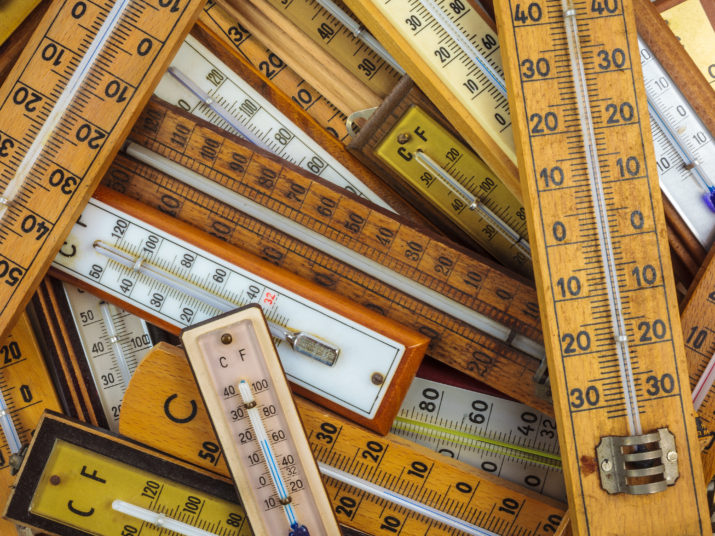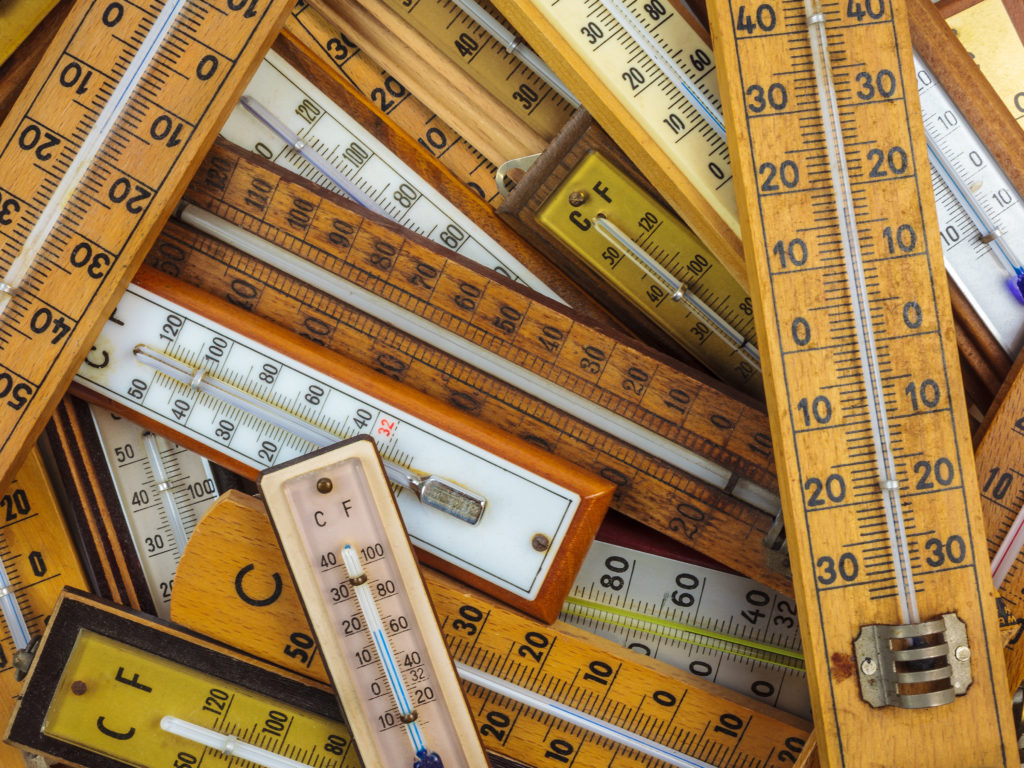
The World’s First Meteorological Network (1654-1670) and Experimental Scientific Society (1657-1667), and the Invention of the Little Florentine Thermometer

This is part of our special feature Facing the Anthropocene.
This article aims at presenting the context for the introduction of the earliest meteorological observations in the world, involving the history of science and historical climatology. These first observations, carried out under the aegis of the Medici family, centered in Florence, Italy, were collected during the 1654-1670 period. A reconstruction of the scientific reasoning behind this innovative idea, the activities conducted, the observers, as well as the stations involved are described. A second aim is to introduce the instrument that was invented through the cooperation of scientists and skilled craftsmen to answer the scientific purposes of a newly emerged Meteorological Network. This instrument, called the Little Florentine Thermometer (LFT) was used to collect daily temperature observations.
Our methodology to retrieve the observations collected under the Network included:
– Reconstructing the history of the Medici Network and the Academy of the Experiments, their protagonists, their national and international contacts;
– Visiting sites (monasteries in Vallombrosa and Florence) where these scientific innovations took place and where scientists in the international meteorological network first applied the Galilean method to the understanding of natural phenomena;
– Researching and retrieving original manuscripts, which, after the French Revolution and the arrival of Napoleon in Italy, were dispersed from their places of origin to unknown libraries after the suppression of monastic orders.
Scientific context and reasoning behind the invention of the first European Meteorological Network (1654-1670) and experimental scientific society (1657-1667)
The Medici Network, which emerged in 1654, can be considered the first European weather service. It can also be linked to the scientific motivations and activities which led to the creation of another important scholarly institution, the Academy of Experiments (1657-1667), considered to be the first experimental European scientific society. The establishment of both scientific institutions can be interpreted by analyzing the wider scientific turmoil that pervaded in Tuscany from the beginning of the 17th century, after Galileo Galilei’s (1564-1642) new discoveries and the establishment of his scientific method (or Galilean method). Science, for the first time had a “method” to proceed to acquire knowledge of objective, reliable, verifiable reality under the guidance of hypotheses to be tested.
Both the Network and the Academy relied on the same interest to discover nature as stated by the teachings of Galileo. “The book of Nature is written in mathematical laws, and in order to understand it, it is necessary to carry out experiments with the objects that Nature makes available to us”[i]. However, the motivations behind each institurion were different:
The Medici Network aimed to:
– Discover key meteorological parameters,
– Invent instruments to measure them,
– Look at the distribution of variables in time and space (Figure 1),
– Discover the fundamental laws of physics, biology and other sciences.
[i] Galilei, G. 1623. Il Saggiatore. Lincean Academy, Rome.

Figure 1: Example of the daily temperature observations and weather description made by observers in the Medici Network (1654-1670). Photo of archival material by authors.
While the Academy of Experiments aimed to:
– Expand on the scientific heritage left by Galileo, continuing to apply the scientific method
– Establish stable contacts between leading scientists of the time in Italy (its members were Ferdinand II, Leopold, and some pupils of Galileo like Torricelli and Viviani) and strengthen contacts with other European scientists
– Know and understand natural phenomena through direct observations and instruments
– Disseminate research findings, i.e. publish the results of the experiments and/or data analysis
The two institutions represent the dawn of modern science after the darkness of the Middle-Ages. They set to abandon a world based on Aristotelianism, traditions or other unproven ideas. They sought to create knowledge based on actual observations of nature with repeated testings, i.e. a new science based on objective and experimental research. In addition, nature was for the first time no longer considered as something revealed to us in a mystical way, but rather, as the expression of phenomena still unknown and that needed explanation. The language to interpret them was mathematics and physics. Quantitative measurements were considered key. Thus, new instruments were needed and they had to be invented for this purpose. Last but not least, a very modern concept, the unknown, was considered so vast that scientists had to work jointly to do research, and share and discuss knowledge.
Examples of fundamental questions that both the Academy and the Network posed and tried to answer were:
- What is the range of temperatures in various countries?
- Does ice always melt at the same temperature, regardless of location or altitude?
- How much does liquid density change with temperature fluctuations?
- What is the temperature difference between sunshine and shadow exposure?
- What is the link between precipitation and river floods?
- What is the velocity of sound?
- How is animal and vegetal life regulated?
Both institutions were funded and politically protected by the Prince Leopold de’ Medici (1617-1675) and his brother the Grand Duke of Tuscany Ferdinand II (1610-1670). The two influential brothers were passionate about science. Hence, they were patrons for the scientists and researchers of their time, such as Galileo Galilei, Evangelista Torricelli and Vincenzo Viviani. They also were personally dedicated to scientific studies and activities. However, these activities lasted only for 10 years. Any “new philosophy” of nature, based on scientific research was distrusted by the Roman Catholic Church and considered too dangerous. Only one year after the publication in 1667 of “Saggi di Naturali Esperienze” or “Essays of Natural Experiments”– the main achievement of the academicians – the Academy was “diplomatically” closed and its members dispersed. Within the Medici Network and for similar reasons, only the Convent of Angels in Florence continued observations. However, in 1670 all activities came to a stop after the Grand Duke died.
The Medici Network (1654-1667) and the Little Florentine Thermometer
The first meteorological network, called Medici Network or Rete Medicea, was composed of 11 stations in Europe (7 in Italy) and was active for the period 1654-1667 (Figure 2). Only Florence’s main station stayed in operation until 1670. The majority of the stations were located in Italy (7 out of 11). The headquarters were located in Florence (station 1), while the other European stations were located in Innsbruck (station 8), Warsaw, Osnabruck and Paris (Figure 3).

Figure 2: Medici Network stations between 1654-1670 (location, period of observations and name of observer)

Figure 3: Map of the Medici Network European stations: Innsbruck (station 8), Warsaw (station 9), Osnabruck (station 10), and Paris (station 11). Map by Bertolin and Camuffo.
It can be considered the first international meteorological network because:
– It held a modern and systematic observational approach (Figure 4-a),
– It used well-planned, regular and careful observational methodology (Figure 4-b),
– It provided technologically and scientifically reliable instruments, all identically built and calibrated by the same person, in the same place (Figure 5), and
– It benefitted from well-trained and skilled observers that were in contact with each other
The Network’s activity was therefore conducted by skilled observers in several locations in Europe. For the first time ever, it consisted in registering outdoor temperature readings with two identical Little Florentine Thermometers hung on a wall facing North and South.

Figure 4-a: Information about the readings collected during the time of the Network and example of the log with daily observations for the station in Vallombrosa. Photo of archival material by authors.

Figure 4-b: Explanation of the reading form. Readings collected by the observers are reported daily, on a single sheet, using a standardized scheme. Each single sheet, as a letter, is adressed to the Grand Duke Ferdinand II. The data was sent to the Florence headquarters weekly.Photo of archival material by authors.
Figure 5: Details of the instruments used within the Network. Identical pairs of Little Florentine Thermometers (LFTs) were used for measurements. The original LFTs used to record the earliest temperature observations in the world are still preserved in very good conditions at the Galileo Museum in Florence, Italy. (http://www.museogalileo.it/en/visit.html). Photo by authors.
How was the LFT invented?
The LFT was the innovation that gave rise to the Network. It grew out of Galileo’s invention of the thermoscope in 1593 – a precursor of the thermometer. This instrument was composed of a graduated glass tube with a glass sphere acting as a bulb on top. The sphere and the upper part of the tube contained an air pocket, while the bottom part was immersed in an open vessel containing a liquid (Figure 5a). The thermoscope was based on the discovery of gas expansion and it used expansion of air with a liquid used as level pointer. However, it was still not a “real” thermometer as it responded to both temperature variations and changes in atmospheric pressure because the latter opposed the air expansion inside the ampulla. Atmospheric pressure was totally unknown in 1593, as it was discovered later by Evangelista Torricelli (1608-1647) in 1643.
At the beginning, the height of the liquid column driven by the air pocket inside the ampulla was observed (as in the case of Galileo’s instrument) and then measured with the help of the graduated tube or drawn on a tablet behind the tube. It was Santorio (1561-1636) who added a scale to the thermoscope (Figure 6). However, the response of the thermoscope was only able to detect qualitative changes in temperature, or relative differences if these occurred within short time periods as opposed to a slow change in atmospheric pressure.
The two possible solutions to move from the thermoscope to the thermometer were:
- Seal the thermometer to avoid the influence of pressure. To this aim a radical change of both the instrument and the expansion of fluid technology was needed.
- Or, after the discovery of atmospheric pressure, add a barometric column to the thermoscope reading to obtain the thermal expansion of air inside the ampulla deprived of the contribution from barometric pressure. This solution would be applied by Amontons[i] in his 1699 thermometer, many years after the Medici Network (Figure 6-b).
Therefore, the novel instrument invented by Ferdinand II and Torricelli in 1641 had to avoid the influence of pressure. The LFT was a liquid-in-glass thermometer with the end of the tube sealed with a flame. This solved also the problem of the evaporation of spirit, although some air at atmospheric pressure was left inside the tube to avoid spirit boiling. It was this “chiusura a fuoco” (heat sealing) of the glass stem that distinguished the liquid-in-glass LFT from previous existing instruments with open stems (i.e. thermoscopes).
[i] Amontons, G. 1702. Discours sur quelques propriétés de l’air, et le moyen d’en connaître la température dans tous les climats de la Terre. In: Mémoires de l’Académie Royale des Sciences, Paris, pp 155–174.

Figure 6. a) Sanctorius Thermoscope (air and liquid pointer) where the pressure in the bulb (PB) plus the pressure of the thermometric liquid (PTL) counteract the atmospheric pressure PAir. b) Amontons Thermometer (mercury) where the pressure in the bulb (PB) counteracts the pressure of the mercury column (PHg ) plus the atmospheric pressure PAir. c) Stancari Thermometer (air) where the pressure in the bulb (PB) counteracts the pressure of the mercury column (PHg ) plus the small pressure (PT) of the saturated vapour and some air entrapped on the top of the tube; the atmospheric pressure has been excluded.
The LFT was based on the thermal expansion of spirit. The latter, although much smaller than air was measurable (the Stancari thermometer was based on air expansion within a sealed tube). In addition, wine was chosen as the thermometric liquid in place of water (since the LFT was a liquid-in-glass, or rather a spirit-in-glass thermometer). This led to further improvements since spirit could resist below water freezing temperature allowing, for the first time ever, the measure of outdoor temperatures.
All the Little Florentine Thermometers were built by Giuseppe Mariani nicknamed “il Gonfia”, or “the Blower” (see Camuffo and Bertolin, 2012 for further details). The LFT has 50 unnumbered labels directly welded onto the tube (Figure 7). On the scale, each label corresponds to one Galileo’s degree. 1°G = 1.4°C (Celsius degree) approximately. For this reason, it was very resistant outdoors and could withstand rain or sunshine.

Figure 7. The Little Florentine Thermometer (LFT) used within the Medici Network (1654-1670) and still preserved in the Galileo Museum in Florence, Italy. It shows 50 unnumbered labels directly welded onto the tube, one white for every 9 black. Photo by authors.
This was such an innovation that the next generation of outdoor-resistant thermometers would only be available over a century later with the “Societas Meteorologica Palatina” when the 18th century custom of using a wooden tablet and a metal or glass support for the tube and scale was (partially) abandoned. The uniformity of the replicas made by “the Blower” and their instrumental precision show an incredibly advanced technological level as proven by Vittori and Mestitz’s research[i], recent studies by Camuffo and della Valle[ii], and Camuffo et al.[iii] where were tested the original thermometers’ reliability and the influence of their reading times on temperature daily means and locations.
The scale resolution and the best fit conversion from °G to °C
Expressed in Table 1 are the scale resolution, the best fit conversion to express the original thermometric scale (i.e. Galileo’s degree (°G)) in present-day scale (i.e. Celsius degree (°C)), as well as the assessment of possible errors due to thermometric liquid and calibration methodology. This data is the results of years of research and testing by Vittori and Mestitz[iv], Camuffo and Bertolin[v], Camuffo and della Valle[vi], and Camuffo et al.[vii] The “solution” for the unknown thermometric scale has required information about calibration or reference points used to build up the temperature scale. However very few metadata were reported in the original documents of the Network or the Academy of Experiments, except for information about the ice melting point measured with the LFT, where 0°C corresponded to 13.5°G.
Table 1. Key features of the Little Florentine Thermometer (LFT)

LFT calibration methodology
When evaluating climate signals over centuries, a possible bias is due to the thermometric liquid used in earlier observations (for the LFT, it was spirit or alcohol). In past liquid-in-glass-thermometers, various types of liquids were tested but often the choice was between the wine spirit, ethyl alcohol, or mercury with different volumetric expansion. Nowadays, we have better knowledge about the relationship between thermometers filled with the most refined alcohol and mercury.
For the LFT, Camuffo and Bertolin showed that “the Blower” solved the technical problem of calibration[1]. Indeed, it was made through a rough control of the scale by using two alternative reference temperature values or reference points recognisable in the temperate climate in Florence (i.e. not calibrated on a scale determined by fixed points at 0°C and 100°C as was customary in the 18th century). The LFT was plunged into the cold water of the Arno River in the winter (1st reference point @ 6 °C) and it was then exposed to summer sunshine (2nd reference point between 30 °C and 40 °C). Assuming the scale to be linear, with two baths (one colder and the other warmer than the environment) it was sufficient to mark the scale on the stems. This explains why the calibration fixed points correspond to non-integer numbers in the LFT (usually, in a mercury thermometer, the melting ice and the boiling water temperatures are marked).
Conclusions
In the 17th century, thanks to technological improvements made by the academicians of the Academy of Experiments and the precision of craftsmen’s work, the LFT was a good quality instrument, the first thermometer in the world able to make reliable outdoor quantitative measurements. This research provides an important understanding of the technology and calibration method behind the invention of the LFT expressly designed for the Network. Vittori and Mestitz[2] compared LFT readings based on 17 original LFTs that had been well preserved. They estimated that the standard deviation between instruments was equal to 0.5°C. This regularity in the LFTs replicated measurements has been recently confirmed by further testing[3] that verified the trustworthiness level of the meteorological data collected within the Network. Finally, statistical tests on temperature data analysis confirms the homogeneity across the locations where the instruments were kept within the Network’s stations, i.e. an outside exposure slightly conditioned by a building structure, on a north-facing cloister wall in a well-ventilated location. Finally, the temperature anomalies, i.e. the temperature difference between the 1654-1670 and the 1961-1990 periods, point out that, in the middle of the Little Ice Age, Florence (the main station of the network) was colder than it is today in autumn (about -0.3 °C), winter and part of spring (about -0.8 °C), while in the summer, it had +0.3°C as mean temperature difference. The station of Vallombrosa, 50 kilometers away from Florence, and located at 1000 meters above mean sea level was instead generally colder than today with a yearly mean temperature difference of about 1.4 °C.
Chiara Bertolin holds a master’s degree and PhD in astronomy from Padua University, Italy. She is Associate Professor at the Norwegian University of Science and Technology (NTNU) in Trondheim (Norway) as part of the NTNU Research Excellence Onsager Fellowship Programme “Zero Emission Refurbishment of the Built Environment”. She is interested in history climatology, microclimate and indoor environmental assessment for cultural heritage preservation. Since 2011, she has also been a member of the Scientific Committee of the National Standardization Body of the Cultural Heritage Commission and of the EU Committee for Standardisation working group on “Specifying and measuring indoor/outdoor climate”.
Dario Camuffo is a physicist, emeritus Research Director at the National Research Council, Institute of Atmospheric Sciences and Climate, Padua, Italy. He is Lecturer of atmospheric, environmental physics and physics for conservation at the Padua University and Polytechnic of Milan. His experience focuses on climate change and environmental factors relating to cultural heritage preservation. He was convenor for the European Committee for Standardisation Technical Committee on Cultural Heritage “Exhibition lighting” and “Specifying and measuring indoor/outdoor climate.”
Photo: Group of wooden thermometers | Shutterstock
References:
Archival documents from Manoscritti Galileiani, Archivio di Stato di Firenze
[1] Camuffo, D. and C. Bertolin, id.
[2] Vittori, O. and A. Mestitz, id.
[3] Camuffo, D., et al, 2017, id.
[i] Vittori, O. and A. Mestitz. 1981. Calibration of the ‘Little Florentine thermometer’. Endeavour 5(3):113–119.
[ii] Camuffo, D. and A. della Valle. 2016. A summer temperature bias in early alcohol thermometers. Climatic change 138 (3-4). DOI: 10.1007/s10584-016-1760-8.
[iii] Camuffo, D., A. della Valle., C. Bertolin, and E. Santorelli. 2017. Temperature observations in Bologna, Italy, from 1715 to 1815: a comparison with other contemporary series and an overview of three centuries of changing climate. Climatic Change. DOI: 10.1007/s10584-017-1931-2.
[iv] Vittori, O. and A. Mestitz, id.
[v] Camuffo, D. and C. Bertolin. 2012. The earliest temperature observations in the World: the Medici Network (1654-1670). Climatic Change 111 (2): 335-363. DOI: 10.1007/s10584-011-0142-5.
[vi] Camuffo, D. and A. della Valle, 2016, id.
[vii] Camuffo, D., et al, 2017, id.
Published on May 2, 2017





